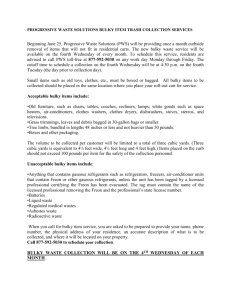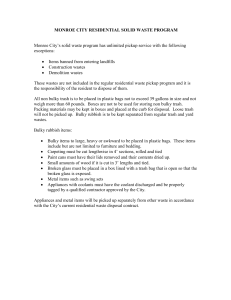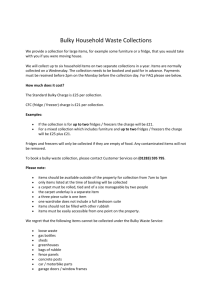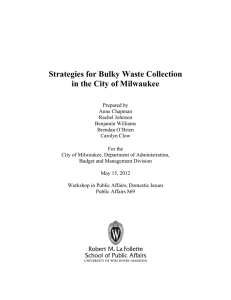Strategies for Bulky Waste Collection in the City of Milwaukee
advertisement
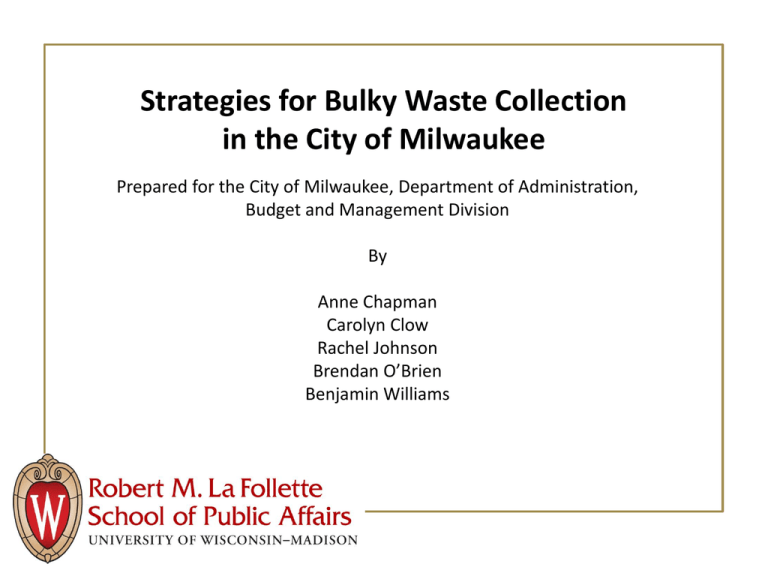
Strategies for Bulky Waste Collection in the City of Milwaukee Prepared for the City of Milwaukee, Department of Administration, Budget and Management Division By Anne Chapman Carolyn Clow Rachel Johnson Brendan O’Brien Benjamin Williams Preview ● Introduction, context, problem statement ● Current policy: History and background ● Policy goals ● Analysis of three policy options ● Recommendation Introduction and Context for Analysis ● Milwaukee operates in an environment of fiscal constraints ● One effective tool: Solid Waste Charge ● Bulky Waste Collection ● ● ● ● ● Extra material outside carts (regular pickup) and special pickups $50 charge for special pickups: Bulky waste in excess of 1 cu. yd. Revenue collected through $50 charge: approx. $100,000 Projected 2012 Cost: $1.1 million Result: Bulky waste program is one of largest drivers of unrecovered solid waste collection costs ● Our report develops policy options for reducing costs, increasing revenues, and improving efficiencies in bulky waste collection Statement of Problem ● Major bulky waste costs ● Employee compensation (salaries and fringe benefits): 60 % ● Fleet and Fuel: 15 % ● Disposal (landfill tipping fees): 10 % ● Bulky waste pickup process: staffing- and equipment-intensive ● Skid pickups primary factor in unrecovered costs ● Cost is $250 each, but revenue is $50 for most pickups ● Disposal costs vary directly with amount discarded ● Policy options could address problem in several ways ● Reduce costs/inefficiencies: Disincentives for bulky waste ● Raise revenues/Recover costs: Higher fees on heaviest users ● Consider impacts on illegal dumping Background: History of Bulky Waste Collection Policy in Milwaukee Change From free collection of all bulky waste to $50 for more than 4 cubic yards each week Effective Date January 1, 2007 Limit for free bulky waste reduced from 4 to 2 cubic yards each week ($50 for > 2 cu. yds.) November 25, 2009 Limit for free bulky waste reduced from 2 to 1 cubic yard each week ($50 for > 1 cu. yd.) January 1, 2011 Current Policy: Options for Residential Bulky Waste Disposal ● If waste is less than 1 cubic yard: DPW crews pick it up, free of charge on regular routes (if too heavy, DPW will send skid loader, at no charge) ● If waste is greater than 1 cubic yard: Property owner must call DPW to arrange for a $50 pickup. If waste left out on regular routes is greater than 1 cubic yard, DPW tags it to inform owner to remove it or be billed for $50 pickup. ● Other options: Self-help centers, Project Clean and Green, Weekend Boxes, subscribe to extra cart service, distribute bulky waste in 1 cubic yard increments every week. Policy Goals ● Efficiency: How well an option maximizes diversion, minimizes cost, maximizes cost recovery and maximizes neighborhood cleanliness ● Fairness: Two concepts of fairness: ● How well an option links amount of resident waste to payment ● How well an option minimizes any unequal burdens on low-income residents and residents in specific geographic areas ● Ease of Implementation: Potential legislative and administrative impacts Policy Options ● Current policy: Waste exceeding one cubic yard in volume requires a special pickup, for which property owners are charged $50 ● Policy option #1: $50 outside the cart fee; one free bulky collection day per month, two cubic yard limit ● Policy option #2: Volume based charges with graduated fee schedule, no free bulky waste. ● Policy option #3: No bulky waste fee; flat increase in solid waste charge to recover all solid waste costs Policy Option #1: Options for Residential Bulky Waste Disposal ● Bulk pickup schedule reduced to once per month, but waste limit increased to 2 cubic yards free of charge ● If waste is greater than 2 cubic yards or for an unscheduled time ● Property owner must call DPW to arrange for a $50 pickup (will be billed) ● Property owner can transmit it themselves to self-help center ● Other options: Same as current policy ● Enforcement: If waste left out on regular routes is greater than 2 cubic yards or on non-collection weeks, DPW tags it to inform owner to remove it or be billed for $50 pickup. Policy Option #2: Options for Residential Bulky Waste Disposal ● Solid waste policy changed to volume based fee system Volume Less than 1 cubic yard Between 1 and 2 cubic yards More than 2, up to 6 cubic yards Fee, in Dollars Projected Number of Charges 50 1,800 75 1,700 200 2,100 ● Other options: Same as current policy ● Enforcement: Estimated number of charges includes a drop-off accounting for tendency to under-charge for bulky waste Policy Option #3: Options for Residential Bulky Waste Disposal ● Revert to 2006 policy: DPW crews pick up unlimited bulky waste, free of charge ● Other options: Same as current policy ● Fee Structure: Direct costs of bulk waste incorporated into solid waste fee (staff, fuel, fleet, and disposal costs). Indirect costs or benefits are not incorporated into initial solid waste charge (nuisance abatement costs). Efficiency Policy option #1: Best cost reduction ● 47% decrease in fuel costs, 27% decrease in fleet direct costs, 2 crews (4 positions) reduced ● Range of estimates: Plus or minus 50% for costs, plus or minus 2 crews (4 positions) Efficiency Policy option #2: Best combination of cost reduction and cost recovery ● Total cost recovery of 638,000 with new fee system, 1 crew (2 positions) reduced ● Range of estimates: Plus or minus 50% cost recovery, plus or minus 1 crew (2 positions) Efficiency Policy option #3: Best recovery of costs ● Addition of 5 crews (10 positions), 71% increase in fuel costs, 41% increase in fleet costs, 50% decrease in nuisance abatement expenses, annual solid waste charge increase of about $9 ● Range of estimates: Plus or minus 33% costs in bulky waste collection and nuisance expenses, 4 – 7 crews (8 – 14 positions), range of charge increase from $8 to $11 Efficiency Gains (Losses) in the Base Scenario* $400,000 $200,000 Staffing Costs $0 Option 1 -$200,000 Option 2 Option 3 Fleet and Fuel Costs Disposal Costs -$400,000 -$600,000 -$800,000 *cost recovery is not included in these gains Fairness: Option #1 slightly increases pay for use, option #2 directly connects fees to usage, option #3 charges everyone same amount, regardless of use ● Policy option #1: Slight improvement in pay for use; increased restriction without change in fees ● Policy option #2: Much stronger connection of paying for use, potential for increased burden on low-income and geographies with high concentration of rental property ● Policy option #3: Much less fair in terms of connecting fees with usage, mixed change in fairness for low-income residents and geographies Ease of Implementation: Option #1 is incremental, option #2 more significant, option #3 a reversal of policy direction ● Policy option #1: Legislative change to ordinances; increases predictability in route schedules, but demands winter contingency plans ● Policy option #2: Significant legislative change to ordinances; expansion in current service and new collection behaviors would require administrative training and follow up ● Policy option #3: Legislative change to past policy; leverage 2006 operations plan to manage administrative adjustments Recommendation: Policy option #1 provides incremental change with optimal mix of cost reduction, fairness ● Follows trajectory of incremental City of Milwaukee adjustments and in-line with “pay for use” values ● Strikes a balance for fairness, restricts frequency of pickups and expands opportunity to dispose of larger bulky items ● Flexible: combined policy options are also a possibility ● Increase in fee for waste from $50 ● For larger volumes, city fee is lower than local market prices For further information Contact the La Follette School’s publications office at 608-263-7657 or publications@lafollette.wisc.edu Thank you

